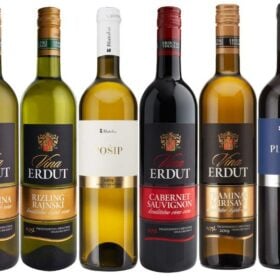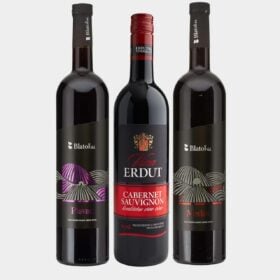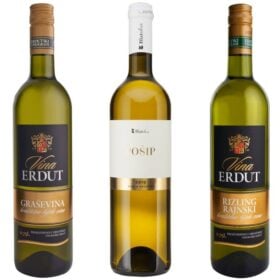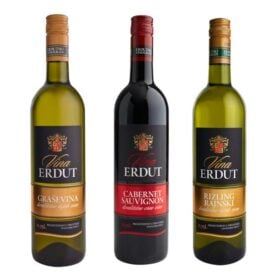Wood aging is an important part of wine production. The process involves wine being stored for a period of time in a wooden barrel. This gives the wine more complexity and firmness. Oak wood is the most commonly used wood for wood aging, because it is strong and allows the right amount of oxygen to pass through. However, winemakers have to make choices about what kind of wood, size of the barrel, old or new wood and the toasting of the barrel. Wood aging is an expensive process, so winemakers should consider carefully whether to use it.
There are so many aspects to consider when making wine, including how to store wine and how to age the wine. When we think of wineries in the old world of France and Italy, then we will probably see rows of barrels ahead of us. These barrels are an important part of the wine world. But there are many differences between them oak barrels which have different effects on the wine you drink.
Content
What is wood aging of wine
Wood aging is a process in which wine is stored for a certain period of time in a wooden barrel. This is an important part of wine production, as it adds complexity and firmness to the wine.
Oak wood is the most commonly used wood for wood aging, because it is strong and allows the right amount of oxygen to pass through. During the maturation process, it gives wood aroma's and flavors add to the wine such as caramel, vanilla, vanilla, spices, and smoky notes. This aroma's and flavors give the wine a complexity. The process of aging in wood can vary from several months to several years, depending on the winemaker's preference and the wine variety.
What types of wood for wine aging
Oak wood is the most commonly used type of wood for making wooden barrels for wine aging. This is because oak wood is strong and allows the right amount of oxygen to pass through. This gives the wine a pleasant taste and aroma, without the wine tasting too much of the wood. In addition, oak wood has a unique set of flavors and aroma's that it gives off to the wine, such as vanilla, caramel, spices and smoky notes.
There are different types of oak that can be used for making wooden barrels, such as European oak (Croatian, French, Slovenian, Hungarian) and American oak. Each type of oak wood has its own unique flavors and aroma's that transfer it to the wine and some winemakers choose a certain type of wood depending on the flavor they want to achieve.
Choices for wine aging in wood
There are several choices a winemaker has to make when deciding to age a wine in wood. One of the first choices is what size of wooden barrel he will use. There are small 225 liter barrels, also called barriques, and larger barrels, also called foeders. Each size has a different effect on the wine and the winemaker must decide which size is best for the type of wine they want to produce.
Another important choice is what kind of wood to use. There are different types of oak wood available, such as European (Croatian, French, Slovenian, Hungarian) or American wood. Each type of wood gives a different taste and aroma to the wine and the winemaker must decide which type of wood best suits the type of wine he wants to produce. The choice of whether new or old wood is used, or a combination, also affects the taste and aroma of the wine. In addition, the toasting of the barrel is also important, which can vary from light to medium roast. It is up to the winemaker to decide which choice to make for wood aging.
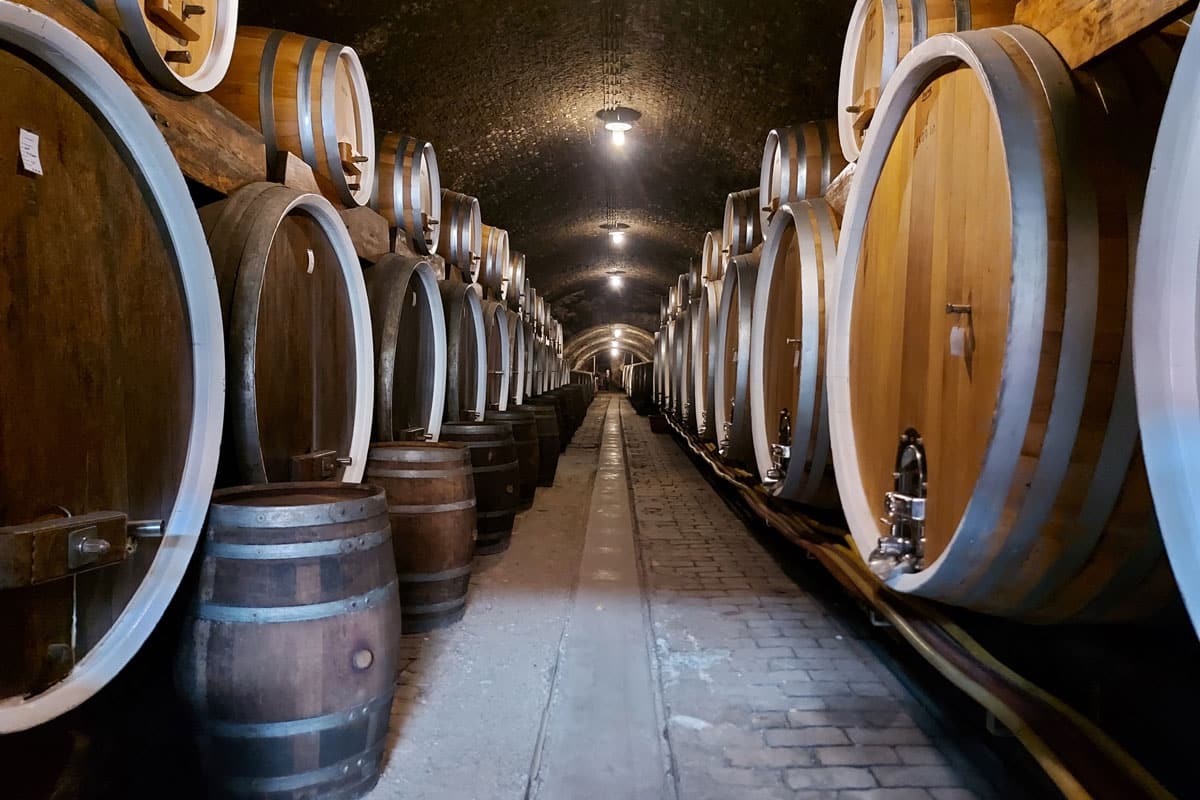
Different types of wooden barrels
There are different types of wooden barrels from which a winemaker can choose for the aging of his wine. The most common are barriques, foeders, tonneaux and demi-muids. Each type of wooden barrel has its own unique properties and flavors that it imparts to the wine.
- Barrels are small wooden barrels with a capacity of 225 liters. These barrels are often made of oak and are often used for maturation red wines. Barriques give a greater amount of woody flavors and aromathe wine compared to larger barrels, causing the wine to mature faster and become more complex in taste.
- Foeders are larger wooden barrels, with a capacity of more than 300 litres. These barrels are often used for the maturation of white wines en Chardonnay. Foeders give less woody flavors and aromaThe wine then matures in barriques, which makes the wine mature less quickly and more fruity aroma's retains.
- Barrels are wooden barrels with a capacity of 500 litres. These barrels are often made from French oak and are often used for maturation red wines, such as Bordeaux and Rhône wines. Tonneaux impart a more subtle woody flavor to the wine than barriques, giving the wine a good balance between fruit and wood.
- Demi muids are barrels with a capacity of 600 liters. These barrels are often made of French oak and are often used for the aging of wines that have a strong flavor and aroma have, like Syrah and Barolo. Demi-muids give a greater woody flavor to the wine than foeders, but less than barriques, giving the wine a good balance between fruit, tannin and wood.
A winemaker often chooses a specific type of wooden barrel depending on the taste he wants to achieve. Some winemakers want their wine to mature faster and therefore opt for smaller barrels, such as barriques. Other winemakers want a longer maturation and opt for larger barrels, such as casks. The origin of the wood and the degree of toasting of the barrels is also an important consideration.
Choosing the right wooden barrel is an important part of the winery, and can have a major impact on the taste, aroma and aging of the wine.
Croatian oak species
The most famous types of oaks in Croatia are: Lužnjak oak, Kitnjak oak, Medunac oak, Crnika oak, Cer oak, Sladun oak, etc. Each of these types of oak has its own unique flavors and aroma's that it releases into the wine, depending on their origin and growing conditions. Lužnjak oak, for example, often grows in humid forests and gives wines a taste of chocolate and spices, while Kitnjak oak grows in drier areas and gives wines a taste of vanilla and red fruit.
The Croatian oak species is a unique and rare species that is often used for wood aging of wine. It is a European oak species that grows in Slavonia and the area of the Dinaric Alps. It has a unique set of flavors and aroma's that it releases into the wine, such as herbs, bitter chocolate and roasted nuts. These taste and aroma's give the wine a complexity and unique character. The Croatian oak variety is often chosen for aging wines such as Plavac Mali, a Croatian grape variety. Because this oak species is so unique and rare, it is often a costly choice for wine producers.
Cherry wood and wine aging
Some winemakers use cherry wood for wine aging because of its unique flavors and aromas aroma's that it releases into the wine. In contrast to oak wood, cherry wood gives a more delicate flavor to the wine, such as red fruit, spices and a light woody taste. This makes it suitable for aging wines that are already delicate aroma have, like white wines, rose wines and some red wines.
In addition, cherry wood can also be used for the tannin in the wine, making the wine feel softer in the mouth. Cherry wood is also less porous than oak wood, which means that the wine evaporates less quickly during aging and is less likely to acquire an excessively woody taste. Winemakers often choose cherry wood when they want a more subtle influence of wood on the taste of the wine.
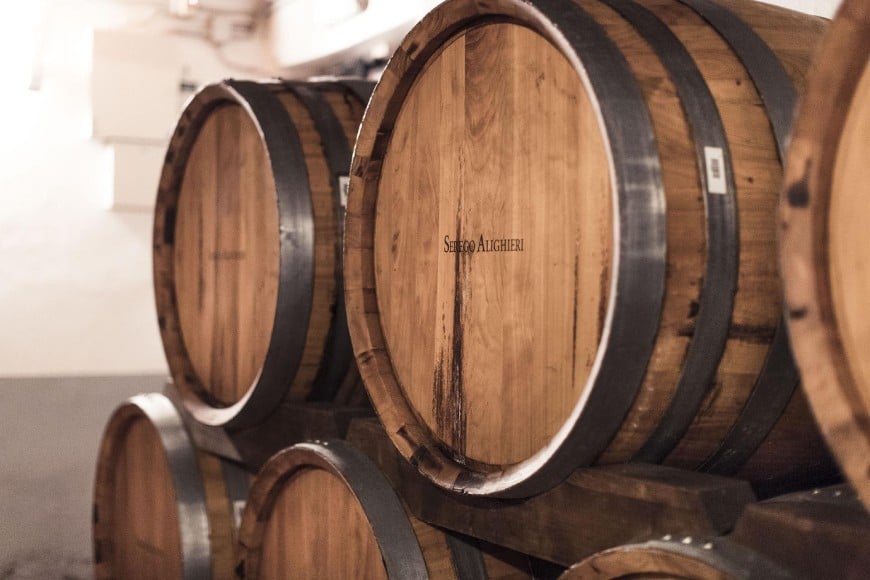
Wine aging in acacia wood barrels
Acacia wood is a less common choice for wine barrels than oak, but some winemakers are experimenting with acacia wood for aging their wine. Acacia wood is known for its fruity aroma's and subtle flavors of herbs and flowers that it gives to the wine. However, it is also a softer wood than oak, so it can set more quickly and provides a shorter maturation time. Acacia wood is often used for the production of white wines en rose.
Wood aging costs
Wood aging is an expensive process for wine producers. A wooden barrel quickly costs several hundred to thousands of euros, depending on the size and quality of the barrel. In addition, wine producers still have to consider other costs such as storage and shipping of the barrel, the maintenance of the barrel and the cost of the wine lost during the aging process.
This can lead to a higher price for the consumer. Therefore, wine producers should carefully consider whether wood aging is a sound investment for their business, depending on their production and sales strategy.
Wine aged in wood chips
Some winemakers add oak wood chips during aging to enhance the wine's flavor without having to age the wine in a wooden barrel. This process is often referred to as "chipping". It adds the flavors and aroma's of oak to the wine, such as vanilla, caramel, spices and smoky notes, without giving the wine the side effects of wood aging, such as tannin and a firmer body.
Adding oak wood chips is also a cheaper way to improve the wine's flavor, compared to using a wooden barrel. Winemakers can add the amount of wood chips they want, and they don't have to consider the size or type of wooden barrel. This gives them more flexibility in the taste of the wine they want to produce.
The influence on the taste
Wood aging can have a major impact on the taste of wine. During the maturation process, it gives wood aroma's and flavors add to the wine such as caramel, vanilla, spices, and smoky notes. This aroma's and flavors give the wine a complexity. Wood maturation can also provide a firmer body and balance in the wine. This is because tannins from the wood are transferred to the wine, changing the flavor structure of the wine.
The type of wood, the size of the barrel, the toasting of the barrel, and the amount of oxygen the wood allows to pass through are all factors that affect the flavor of the wine. Winemakers must therefore choose carefully which choices they make for wood aging to achieve the desired taste.
How do you church wine that has been aged in wood
Wood aging can be recognized by the aroma's and flavors that the wine has. Wines aged in wood will often have notes of caramel, vanilla, spices and smoky flavors, these notes come from the wood. In addition, wood maturation can also be recognized by the flavor structure of the wine, which will often be more complex and have a firmer body.
In addition, wood aging can also be recognized by looking at the label of the wine. Many wine producers state on the label whether the wine has been aged in wood and how long the aging has taken place, this is a good indication of whether the wine has been aged in wood.
It is important to know that not all wines are aged in wood, some wines are aged in stainless steel or concrete barrels or have not even had any maturation.
Is every wine suitable for wood aging?
Not every wine is suitable for wood aging. Some wines are more sensitive to barrel aging than others. For instance, white wines are often more sensitive to wood aging than red wines. This is because white wines are often more delicate in taste and faster aroma's losses when they are in contact come with wood. Therefore become white wines often aged in stainless steel or concrete vats, or not aged at all, to preserve the delicacy of the flavour.
Some red wines are also not suitable for wood aging. For instance, Pinot Noir is often aged in concrete barrels or small wooden barrels, as it is a delicate grape variety and too much wood aging can lead to an overly intense flavor. On the other hand, wines such as Cabernet Sauvignon en Syrah are often suitable for wood aging, because they have a firm flavor structure and can gain more complexity through wood aging. So it depends on the wine type and the winemaker's preference whether a wine is suitable for wood aging.
How long should wine age?
The aging process of wine in wooden barrels depends on the taste that the winemaker wants to achieve. Some winemakers choose short aging of several months, while others age their wines for years.
A young wine aged only a few months in wooden barrels will have a lighter woody taste, while retaining the fresh fruity aromas. Wines that are aged longer will have a more complex flavor, with more woody notes, such as vanilla, caramel and smoky notes.
In addition, the size of the barrels also plays a role in how long the wine should be aged. small barrels, called barriques, age the wine faster than the larger barrels, called foeders.
So winemakers have to decide how long they want to age their wines in wooden barrels, depending on the taste they want to achieve. There is no right or wrong time for barrel aging, it is a matter of personal taste and preference.

Other materials
Wine aging is an important part of winemaking and has a major impact on the taste of the wine. Traditionally, wine barrels are made of wood, such as oak, because this wood allows the right amount of oxygen to pass through and gives the wine a more complex taste. However, nowadays there are other materials used for wine barrels, such as concrete, stainless steel and plastic. These barrels do not affect the taste of the wine, preserve the natural flavors of the grapes and are more durable and hygienic.
Wine aging in stainless steel tanks
Inox barrels, also known as stainless steel barrels, are another alternative to wooden barrels and are widely used in the wine industry. Inox drums are made of stainless steel, a durable and hygienic material. The barrels are resistant to corrosion and discoloration, and ensure efficient wine aging. Stainless steel barrels do not provide flavor or aromatransfer to the wine, as wooden barrels do, preserving the natural flavors of the grapes. The barrels are also easy to clean and have a longer lifespan than wooden barrels. Stainless steel drums are often used for the production of white wines en rose, and are also suitable for storing red wines and the production of sparkling wine such as champagne.
Wine aging in concrete barrels
Concrete wine barrels are an alternative to traditional wooden barrels and are becoming increasingly popular in the wine industry. They are made of reinforced concrete and are lightweight, making them easy to move. They are also relatively cheap to purchase and maintain. The concrete barrels give no taste or aroma to the wine, preserving the natural flavors of the grapes. The concrete barrels are also easy to clean and have a longer lifespan than wooden barrels. Therefore, they are often used for the production of white wines en rose, and are the preferred choice of some winemakers.
Plastic barrels and wine aging
Wine aging in plastic barrels is a recent development in the wine industry and is becoming increasingly popular. Plastic drums are lightweight, durable, inexpensive and easy to transport and clean. Just like stainless steel barrels, plastic barrels don't taste or aroma to the wine, preserving the natural flavors of the grapes. Plastic barrels are also 100% airtight and therefore ensure efficient wine aging. However, plastic barrels are often larger than wooden barrels, so some winemakers find that the wine ages less quickly than in wooden barrels. Plastic barrels are often used for storage white wines en rose, but plastic barrels are also suitable for the production of red wines.
Wine aging in glass barrels
Wine aging in glass barrels is a rare practice in the wine industry because glass barrels are very fragile and costly. However, some winemakers are experimenting with glass barrels for aging their wine. Glass vessels do not impart any taste or aroma the wine, as wooden barrels do, preserving the natural flavors of the grapes. Glass barrels are also easy to clean and have a longer lifespan than wooden barrels. However, glass vessels are not suitable for storing wine for a long time, because the wine matures quickly due to the transparency of the glass. That is why glass vessels are often used for tastings or for small editions of special wines.

Croatian wine and wood aging
Croatian wines that are aged in wood give a unique taste experience. One of the most popular wines to be aged in Croatia is Plavac Mali. This grape variety is often aged in wooden barrels of the Croatian oak variety, which gives the wine a unique character of spices, bitter chocolate and roasted nuts.
Also the wines from the Istria region, such as the wines made from teran grape, are often aged in wooden barrels, giving the wine a taste of coffee, tobacco and spices.
These wines often have a complex flavor and a firm body due to the wood aging. Because the Croatian oak species is so unique, this ensures a unique taste experience for the taster.
Popular wine from Croatia
Croatian wines are increasingly in demand for their unique flavors and characters. Viticulture in Croatia dates back to ancient times and has a long history. Many different grape varieties are grown in Croatia, such as Plavac Mali, grk, Posip, Malvasia en Teran. Each with their own unique flavors and characteristics.
Most wines from Croatia are dry, with a rich structure and a good balance between acidity en tannin. Most red wines are made from grape varieties like Plavac Mali, Babić, riding a Dingach, which are often aged in wooden barrels, making the wines more complex in taste. White wines are often made from grape varieties such as Malvasia, grk, Posip and these are often aged in stainless steel barrels.
Croatian wines are available in a wide range of price ranges, from affordable wines to prestigious wines with a nice aftertaste. Wines from Croatia are increasingly recognized on the international wine market, and are highly recommended for those looking for something unique and flavorful.
Now that you know more about wine and barrel aging, it's time to share your thoughts! Do you recognize the flavors and aroma's who adds oak to wine? Wood aging, do you like it or not? Share your thoughts below this post in the comments!


